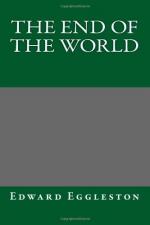[Footnote 1: Not until my attention was called to this word in the proof did I know that in this sense it is a provincialism. It is so used, at least in half the country, and yet neither of our American dictionaries has it.]
“I dells you tese Yangees is Yangees. Dere neber voz put shust von cood vor zompin. Antrew Antershon is von. He shtaid mit us ven ve vos all zick, unt he is zhust so cood as if he was porn in Deutschland. Put all de rest is Yangees. Marry a Deutsche vrau vot’s kot cood sense to ede kraut unt shleep unter vedder peds ven it’s kalt. Put shust led de Yangees pe Yangees.”
Seeing August put on his hat and go to the door, he called out testily:
“Vare you koes, already?”
“Over to the castle.”
“Veil, das is koot. Ko doo de gassel. Antrew vlll dell you vat sorts do Yangee kirls pe!”
CHAPTER V.
AT THE CASTLE.
By the time August reached Andrew Anderson’s castle it was dark. The castle was built in a hollow, looking out toward the Ohio River, a river that has this peculiarity, that it is all beautiful, from Pittsburgh to Cairo. Through the trees, on which the buds were just bursting, August looked out on the golden roadway made by the moonbeams on the river. And into the tumult of his feelings there came the sweet benediction of Nature. And what is Nature but the voice of God?
Anderson’s castle was a large log building of strange construction. Everything about it had been built by the hands of Andrew, at once its lord and its architect. Evidently a whimsical fancy had pleased itself in the construction. It was an attempt to realize something of medieval form in logs. There were buttresses and antique windows, and by an ingenious transformation the chimney, usually such a disfigurement to a log-house, was made to look like a round donjon keep. But it was strangely composite, and I am afraid Mr. Ruskin would have considered it somewhat confused; for while it looked like a rude castle to those who approached it from the hills, it looked like something very different to those who approached the front, for upon that side was a portico with massive Doric columns, which were nothing more nor less than maple logs. Andrew maintained that the natural form of the trunk of a tree was the ideal and perfect form of a pillar.




